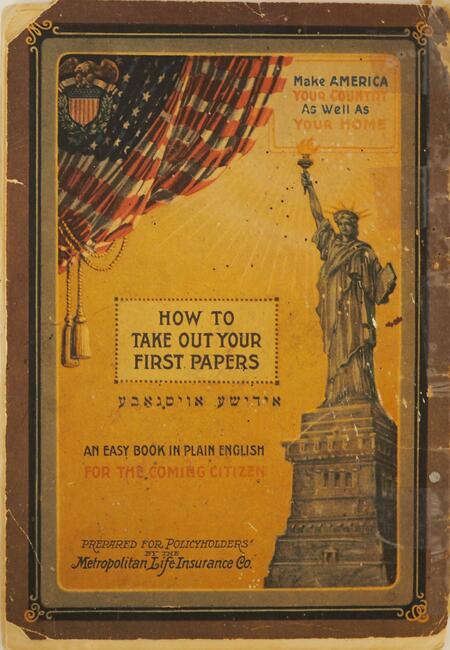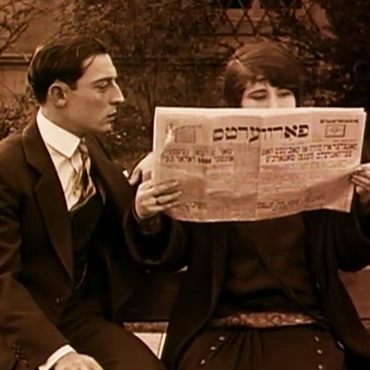Make America Your Country as Well as Your Home
Jewish immigration to the United States
From 1881 to 1924, more than two-and-a-half million Eastern European Jews made their way to the United States. But a series of restrictive laws passed between 1921 and 1924 brought this period of immigration to an abrupt end. Jewish immigration to the United States from Eastern Europe never again reached its pre-1920 height.
Ironically, this informative little booklet with the title “How to Take Out Your First Papers” was translated into Yiddish and then published in the early 1920s, right around the time that these restrictive immigration laws were being passed. The book’s cover advertises it as “an easy book in plain English for the coming citizen,” and in the upper-right corner are the words “Make America your country as well as your home.”

In a combination of English and Yiddish, the book guides the new immigrant through the process of filing the papers needed to become citizens of the United States of America. The booklet teaches the necessary English language skills to successfully complete the paperwork. As a result, physical characteristics, including skin color and complexion, even made it into this brief English lesson.
Also included are examples of the paperwork itself. This document from an Irishman in 1904 includes a renunciation of King George V, king of Great Britain and Ireland, in addition to declarations that the signee is neither an anarchist nor a polygamist:
New laws regarding the “Citizenship of Married Women” are presented, which clarify that even if a woman marries a citizen of the United States, she must still take out her own citizen papers. But if her husband is someone who cannot become a citizen by law, then neither can she, while she is still married to him:
Facts about the United States ensue, with some portraits of figures in American history, as well as listings of presidents, states, and the current population:
There is an advertisement for the Immigrant Service and Citizenship Bureau, with fingerprint stains and all:
A listing of recommended reading appears toward the end of this short volume:
And, of course, the national anthem, with instructions about what to do when it plays (everyone must stand, and men remove their hats):
The booklet opens with an image of the Capitol in Washington, D.C., and concludes with a color image of the American flag and Betsy Ross:
Inside the only copy that has reached us thus far is a short handwritten note, stating that the booklet belonged to the donor’s mother-in-law, Celia, who used it to prepare for citizenship in the early 1920s. Celia lived out the rest of her life in the United States.
For more reading on this fascinating topic, consider the following resources from the Yiddish Book Center’s Steven Spielberg Digital Yiddish Library:
Vos yede froy darf visen vegen birgershaft (What Every Woman Should Know about Citizenship), published in New York in 1926 by the National Council of Jewish Women. Click here to view the book.
Lehr-bikhel fun di fareynigte shtaaten far di informatsyon fun imigrantn (Manual of the United States for Information on Immigration) published in 1925 by the Daughters of the American Revolution; click here to view the 1925 edition. A revised edition titled Lern-bikhel fun D.A.R. far birgershaft (D.A.R. Manual for Citizenship) was published in 1940—note the upside-down line printed on the title page. Looks like that edition was printed with a linotype. Click here to view the 1940 edition. Another edition was published in 1948 with a relatively lengthy section in English. Click here for the 1948 edition.
Vi tsu veren a sitizen (birger) fun di fereynigte shtaaten (How to Become a Citizen of the United States) published in 1922 in New York. Click here to view the book.
Undzer demokratishe yerushe (Our Democratic heritage) was published in 1954 and contains Yiddish translations of the Declaration of Independence, the United States’ Constitution, the Bill of Rights, Lincoln’s Gettysburg Address, and the Emancipation Proclamation. Click here to view the book.
— Elissa Sperling



